BAL Scrapbook, 2003For a look at more Book Arts League events, please visit
|
||||||||||||||||||||||
|
||||||||||||||||||||||
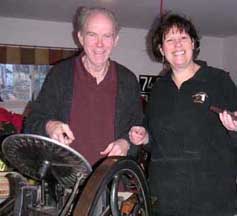 |
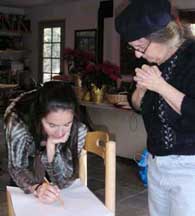 |
|
|
|
Evert Brown, Brenda Gallagher, and Louise Padden joined forces for an after-dinner session of collating and packaging the 2003 Ephemera Exchange at Gail Watson's studio. The Exchange's arrival made it seem like a special Holiday present for the participants.
The Exchange, organized and collected by Gail, continues to be an always lively and often surprising collection of small graphic pieces, and a favorite activity of BAL members and friends.
A few sets of the 2003 edition are being offered for sale at $25, benefitting the League. Please contact .
Deadline for the 2004 Ephemera Exchange is October 1, 2004. All matter must be 5" x 7", in an edition of 30.
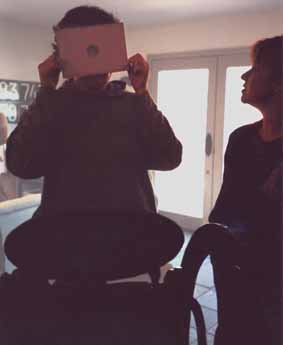 |
|
I spy... Gail Watson looks through her work while Nancy Missbach looks on.
Photo: Kay Moller |
Gail Watson taught an exploration of the "dry" processes of embossing/debossing, diecutting, and foil stamping at her studio in Golden Gate Canyon, Saturday, October 11.
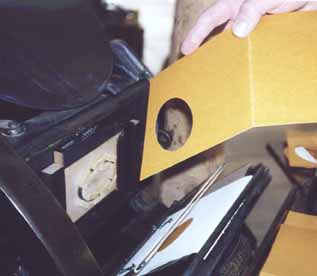 |
|
Cut to the chase... The die cutting was done on Gail's Pearl Press.
Photo: Kay Moller |
Play the -->MOVIE<--
by Tracy Bellehumeur
NOTE: 3.2 MB File!
Besides die cutting on the platen press, the group explored using dental polymer to make "counters" for embossing, which was done using the foil stamper.
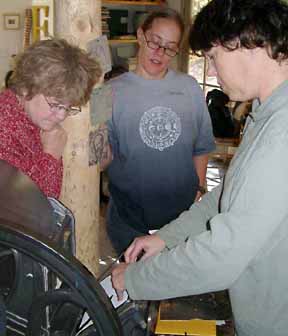 |
|
Two to Make Ready... Linda Bevard (L) and Alicia Bailey watch as Gail prepares the platen.
Photo: Tracy Bellehumeur |
And after all the work and experiment, a birthday cake for Julia, baked by Linda Bevard. Workshop Attendees: David Ashley, Alicia Bailey, Tracy Bellehumeur, Linda Bevard, Nancy Missbach, Kay Moller, Julia Seko, Nancy Warnke.
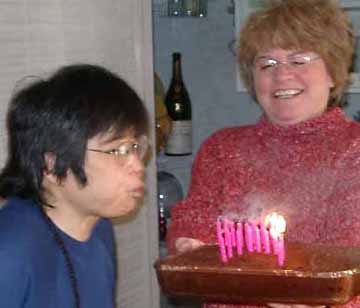 |
| And one to blow... is that sixteen candles?
Photo: Tracy Bellehumeur |
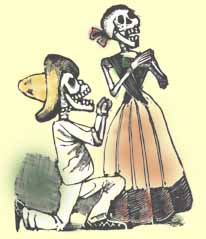
The first and second days of November mark the Day of the Dead, widely celebrated throughout Latin America as a time in which the dead have permission to visit their relatives and friends on earth. This custom derives from ancient times, when the Aztecs devoted two full months of their calendar to the dead. Throughout Mexico, the observance involves the cleaning and decorating of grave sites and home altars, and colorful food offerings including sugar skulls and los panes de muertos, the "bread of the dead."
This holiday also has a tie with printing, in the custom of calaveras, or "skulls," described by Cloë Sayer as "witty epitaphs written for friends and celebrities while they are still alive." These were often circulated as broadsides, and often featured skeletons. This November 1, a group of BAL members and friends met at Julia Seko's home to sample mole, tamales and each other's potluck delicacies and to play with printing techniques employing collage.
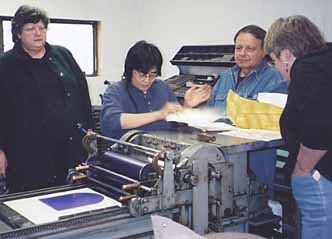 |
|
|
They made whimsical "tombstones" in the form of a pressure print (similar to doing a brass rubbing) and experimented with collographs, a collaged surface that was inked and printed. The tombstones were made into a "cute little accordion book," said Julia. "Some were silly, too, I think."
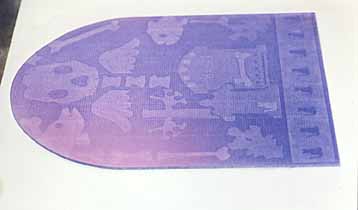 |
|
|
Attendees included Jill Berry, Alice Turak, David Ashley, Terry Kasperzak, Nancy Warnke, Linda Bevard, Earl Noe and Brenda Gallagher.
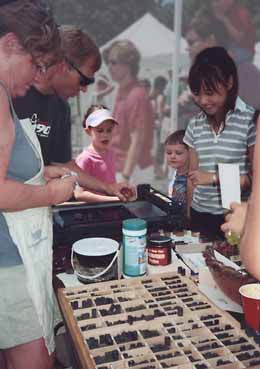
Linda Bevard and Alan Warner man the press at the Lafayette Peach Fest in August. Visitors could pick a cut and have their name set in metal type and printed. As is so often the case, this was a big hit with the kids. Kay Moller, Julie Seko, and Earl Noe helped out. Photo: Kay
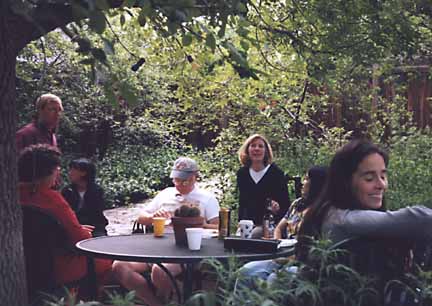
League members met at Limbo Ranch in June for the organization's Annual General Meeting, to plan, socialize, and choose officers. Shown above (L-R) are: Nancy Warnke, Alan Warner, Janet Kiota, David Ashley, Alicia McKim, Julie Seko, and Brenda Gallagher.
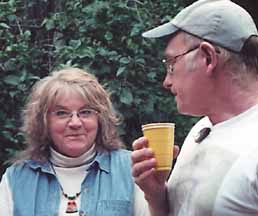 |
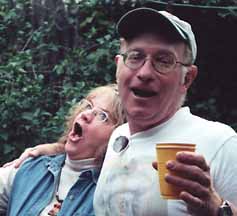 |
|
|
|
Members and guests dined alfresco on a sumptuous potluck, and experimented with Gyotaku, Japanese Fish Printing, using a real, redolent, and not rubber, fish provided by Gail Watson.
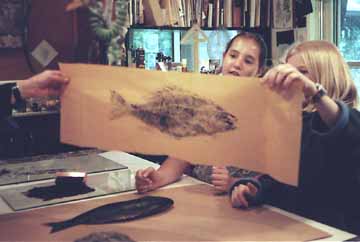
Julie Seko was reelected president, Laura Tyler was named vice-president, and Linda Bevard continues as secretary-treasurer.

Photos: Kay Moller

The technique of wood engraving was one of the key technologies that led to our modern, graphics-rich modes of communication, Diane Wray said at a Book Arts League sponsored talk on "The History of Wood Engraving." Early illustrated printed works usually relied on either wood blocks or etchings for images. Wood cuts could not reliably stand the pressure of printing in a press, and etchings are an entirely different process, so illustrations had to be tipped in separately and could not be produced as rapidly as the text could be printed from movable type.
In contrast to wood blocks using the plank or long grain, wood engraving relies on the dense, fine end grain of woods such as maple or boxwood. This allowed for durable, type-high blocks that could be freely mixed with type. In addition, the dense end grain allowed the development of a very detailed white-line technique that could portray fine detail and yield dramatic illustrations with a full range of tonal values.
Hence, wood engraving prefigures the halftone process that is today universally used in printing continuous tone images. With an affluent middle class hungry for printed material and improved distribution through the railroads, the 19th century saw the rise of elaborately illustrated periodicals that provided dramatic coverage of news such as the Civil War and the Gold Rush. Ultimately, thousands of skilled engravers worked to produce the images for periodicals. As the cheaper photoengraving process became prominent, wood engraving persisted for a time in the form of illustrations for catalogs. Today, it is practiced primarily as a form of fine art printmaking and for illustrating limited-edition books.
Ms Wray's March 11 talk coincided with a monthlong exhibit of wood engravings, blocks and tools in the main lobby of the Lafayette Public Library and a March 15 "Wood Engravings Basics" workshop taught by Laura Tyler. Last year Ms Wray donated a collection of historic tools and engraved blocks to the League. She studied printmaking and holds a degree in fine arts from the Art Institute of Chicago. She worked three years for the Sander Wood Engraving Company in Porter, Indiana. There, she assisted with the preparation of a book on the history and technique of wood engraving and a mail-order catalog of wood engraving supplies. She was also involved in the organization of a gallery devoted to wood engraving prints and a library of historic wood engravings. She now works as a historic preservation consultant in Denver.
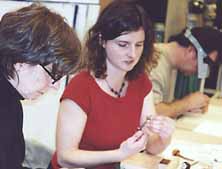
Laura Tyler (above, center) guided a varied group including both experienced book artists and beginners through "Wood Engraving Basics" in a March 15 workshop in the Lafayette Public Library's Art Center Room. Making use of the vintage engraving tools donated to the League by Diane Wray, the group covered basic theory and types of wood used for engraving, how to select a design and prepare the block, the different types of engraving tools, how to size the tool for the individual hand, sharpening, and holding the tool and cutting.
The class then spent most of the remaining time engraving and proofing a "sampler" block of parallel and curved lines and a simple, three-dimensional shape. It was a challenging and interesting introduction to a historic art that gave the participants a deepened appreciation for the virtuosity of the thousands of vanished 19th century wood engravers, many of whom practiced their trade in anonymity. Several people who took the class expressed an interest in continuing with this difficult technique, and the League may hold additional wood engraving workshops.
Participants in the class were: Alicia Bailey, Rob Barnes, Gail Jennings, Mark Lacey, Nancy Missbach, Kay Moller, Earl Noe, Sherman Sipe, and. Rob Slentz. (photo by Kay Moller)
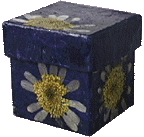 Decorative Box Making Workshop
Decorative Box Making Workshop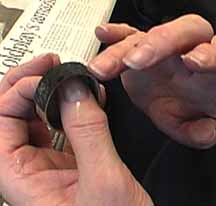 Laura Tyler led a class in making beautiful decorated boxes from the humblest scraps of paper, beads, and pressed flowers.
Laura Tyler led a class in making beautiful decorated boxes from the humblest scraps of paper, beads, and pressed flowers.
The February 1 class at the Lafayette Public Library's Art Center was just in time for Valentine's Day.
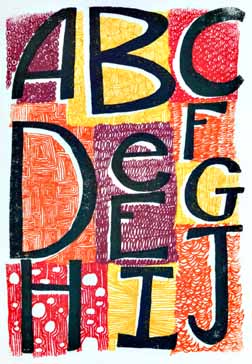
"An Alphabet for James" (detail) by Brenda Gallagher
The 2002.1 Ephemera Exchange is now out! A very limited number of copies of this lively art show of small, wildly inventive printed works will be available for sale to benefit the League. To avoid disappointment contact Gail at 303 443-9886 x115 or
A few Ephemera Exchange compilations for 1996, 1997, and 2000 may still be available. Send $20 plus $3 P&H to: Linda Bevard, PO Box 1544, Boulder, CO 80306-1544.